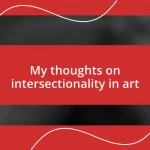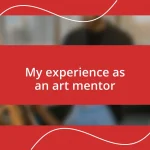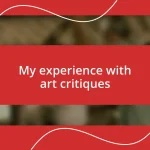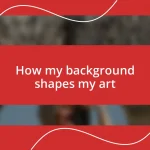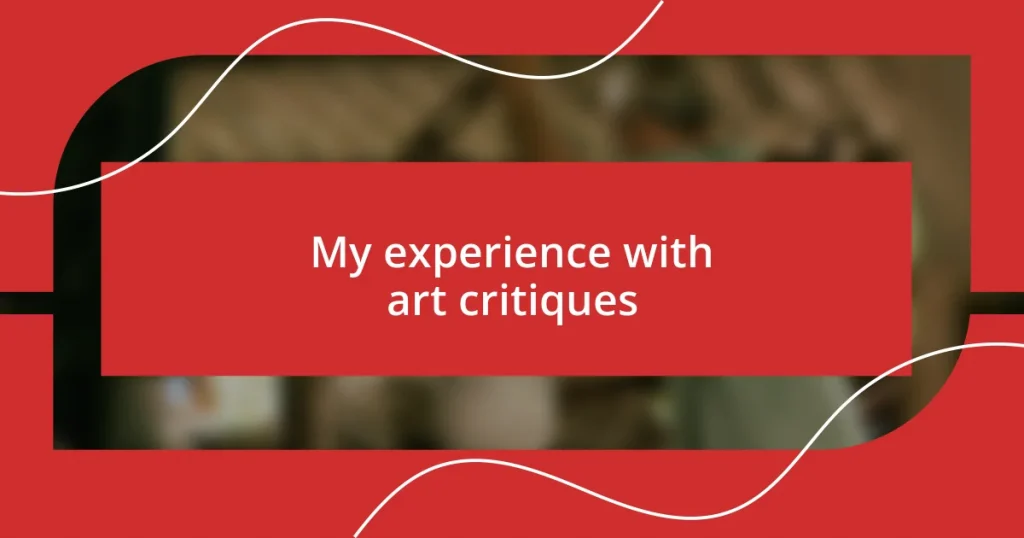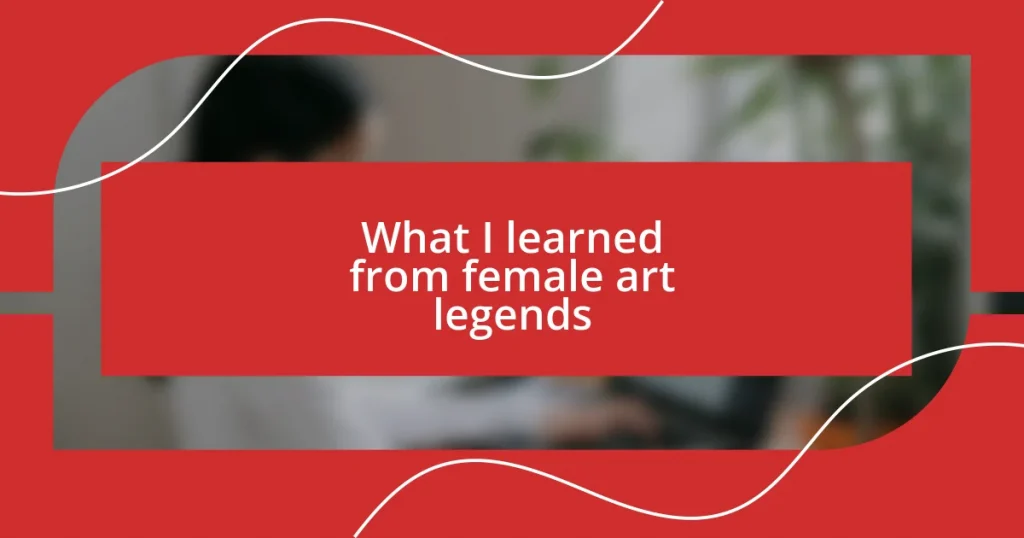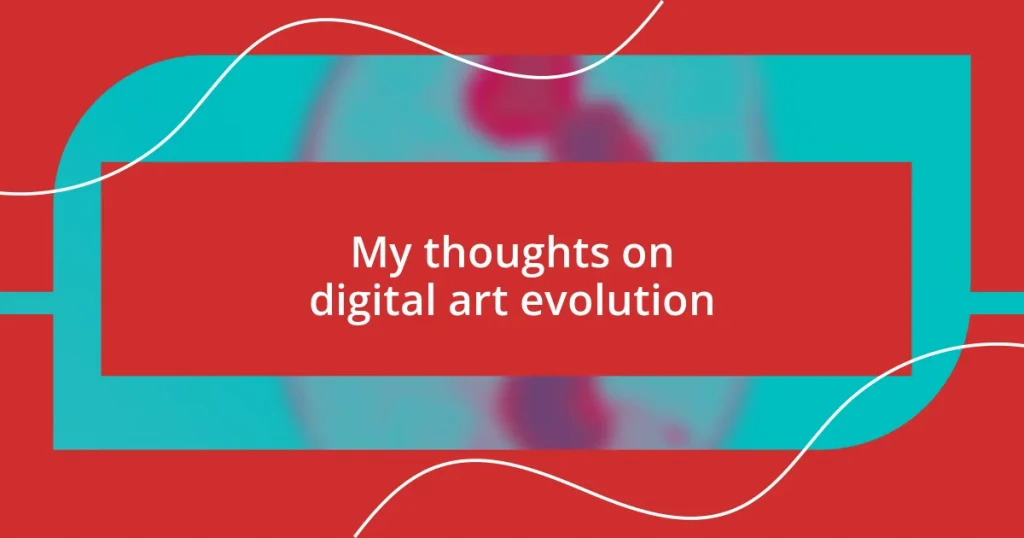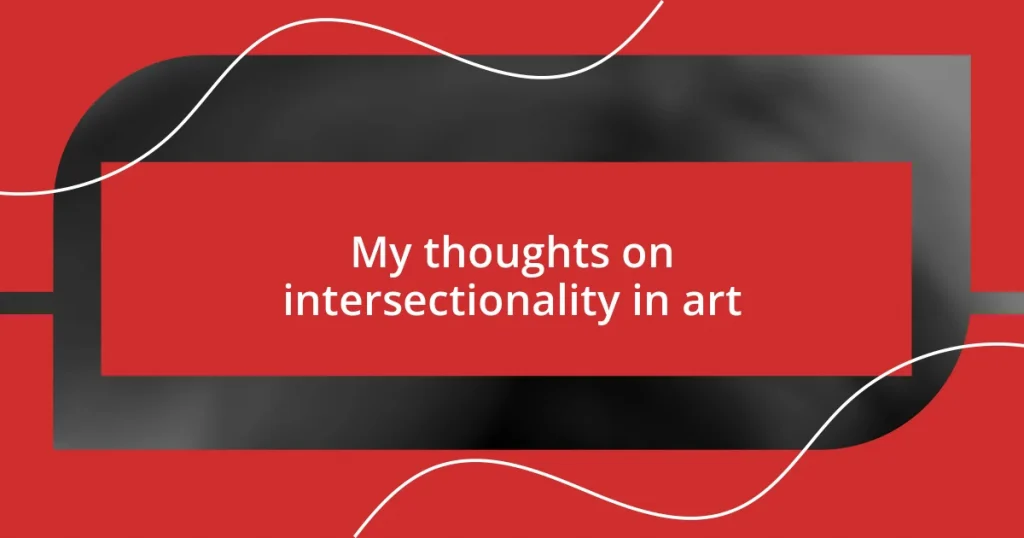Key takeaways:
- Initially intimidated by critiques, the author learned to view feedback as a catalyst for artistic growth and exploration.
- Effective preparation for critiques, including self-reflection and requesting specific feedback, enhances the experience and fosters openness to constructive criticism.
- Implementing feedback requires patience and experimentation, leading to richer artistic expression and deeper understanding of one’s work.
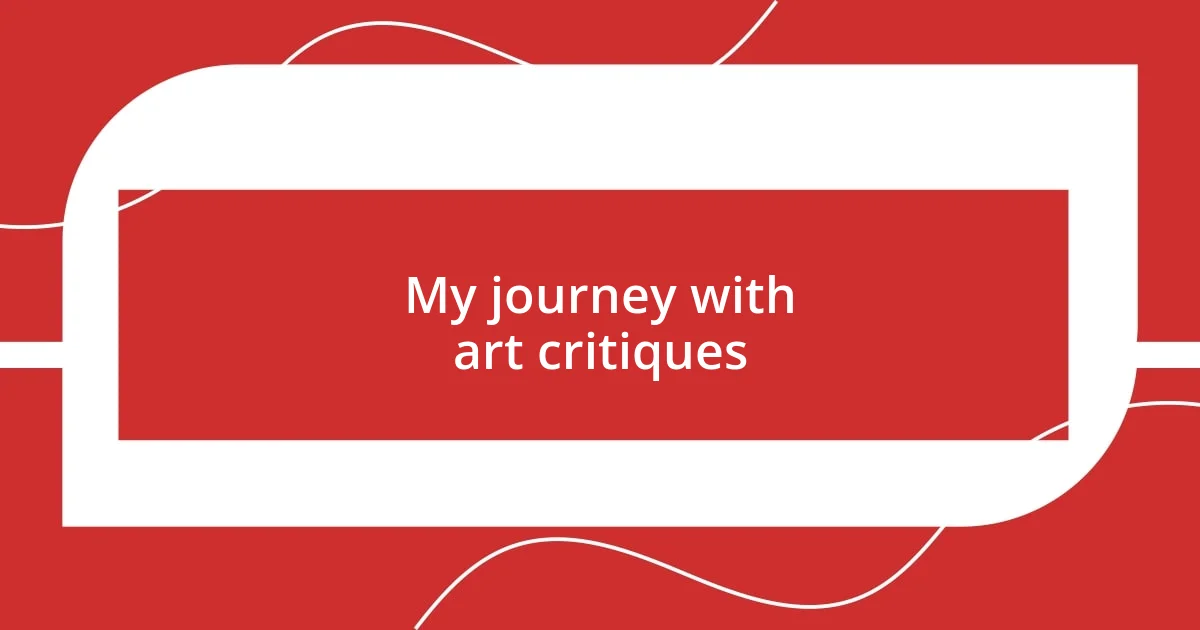
My journey with art critiques
In my early days as an artist, critiques felt like a daunting mountain I had to climb. I remember the first critique session I attended; my palms were sweaty, and I sat nervously, listening to seasoned artists dissect each piece. Why was it so nerve-wracking? Because I poured my heart into my work, and to have it scrutinized was intimidating, yet it was a necessary step in my growth.
Over time, I learned to embrace the feedback rather than fear it. One memorable moment was when a fellow artist pointed out a unique perspective in my painting that I hadn’t noticed myself. Their insight sparked a whole new direction for my work, prompting me to explore that aspect further. Isn’t it fascinating how others can see what we sometimes overlook?
Reflecting on my journey, I realize that every critique is a stepping stone. With each piece of feedback, I’ve grown not only as an artist but also as an individual. Recognizing the value of diverse perspectives transformed my approach to art and deepened my understanding of my creative voice. I’ve come to see critiques not as judgments, but as conversations filled with potential for growth and exploration.
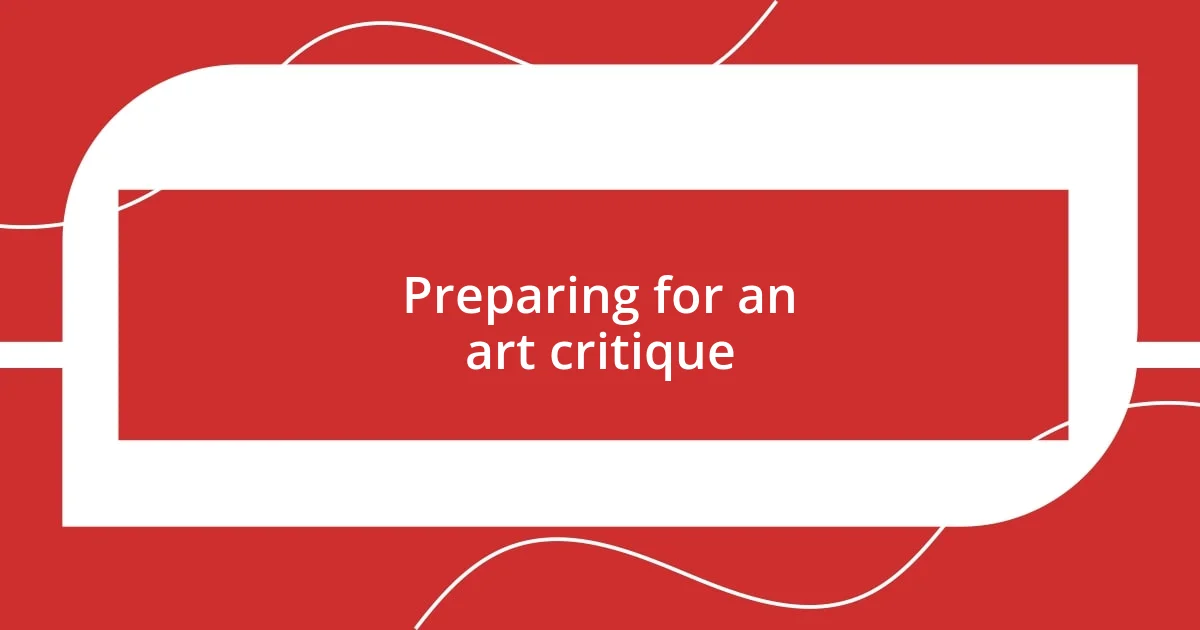
Preparing for an art critique
Preparing for an art critique can feel overwhelming, but I’ve discovered that a little preparation goes a long way. Before stepping into the critique room, I find it incredibly helpful to revisit my piece with fresh eyes, distancing myself emotionally from it. I remember a time when I approached a critique session with trepidation, clutching my sketchbook tightly. I spent some time examining my work, thinking about my intent, and considering what feedback I wanted to hear. This grounding practice made it easier for me to receive constructive criticism with an open mind and heart.
To effectively prepare for an art critique, I recommend:
- Review Your Work: Take a moment to analyze your piece and reflect on your artistic choices.
- Identify Goals: Think about what specific feedback you hope to gain. This could be about technique, composition, or emotional impact.
- Stay Open: Cultivating a mindset of openness can transform your critique experience. Remember, feedback is meant to help you grow.
- Practice Active Listening: Engage with each comment made, and resist the urge to be defensive. This mindset will enrich your understanding.
- Take Notes: Jot down key insights; you’ll appreciate having a reference later as you refine your craft.
By approaching critiques in this structured way, I’ve found that my confidence grows, and the experience becomes less about judgment and more about shared learning and artistic discovery.
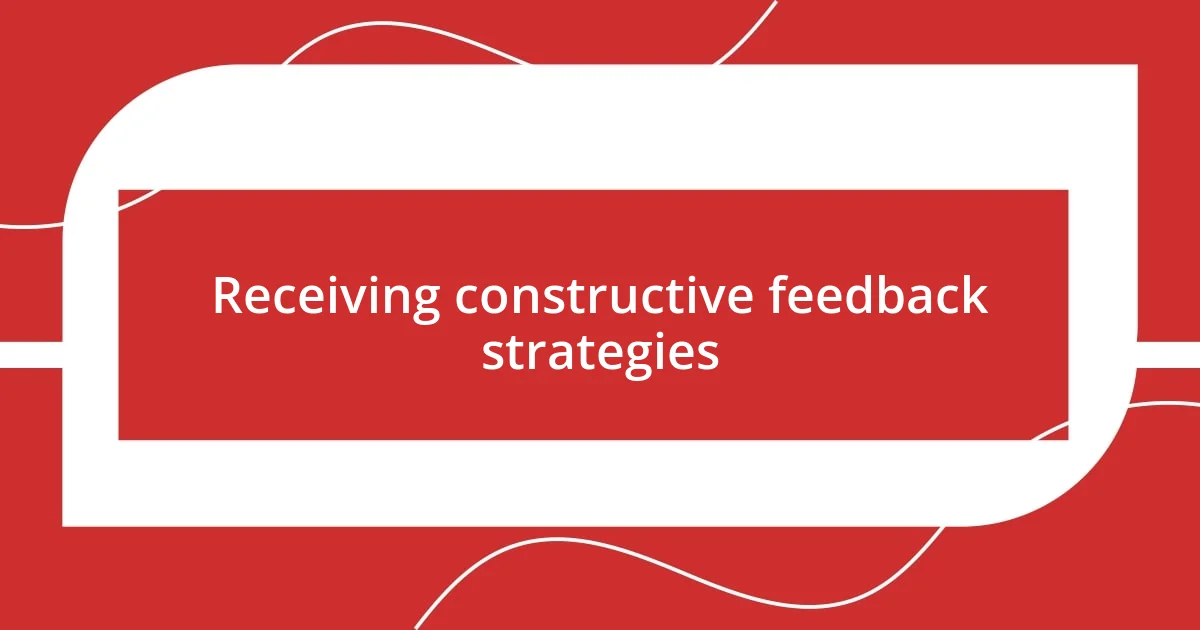
Receiving constructive feedback strategies
Receiving constructive feedback can be a game changer in an artist’s journey. One approach that has helped me tremendously is to explicitly ask for feedback on certain elements of my work. For example, during a critique, I once asked for specific thoughts on my use of color. Surprisingly, this simple question opened up a dialogue that not only clarified my intent but also shed light on how I could enhance the emotional depth of my pieces. Have you ever tried guiding the feedback you receive? It can give you more control over your artistic evolution.
Another strategy is to focus on the positive aspects of feedback before diving into the critiques. I recall a time when I received a lot of constructive criticism that felt overwhelming. Instead of getting defensive, I took a moment to acknowledge the strengths in my work as highlighted by others. This process shifted my mindset; I went from feeling vulnerable to empowered, ready to tackle the suggestions given. Being able to recognize what’s working in addition to what could improve makes feedback feel like a balanced exchange rather than a list of flaws.
Lastly, I’ve found it beneficial to create a space for self-reflection after receiving feedback. After a particularly intense critique, I like to set aside time to digest the insights. I remember sitting in my studio one evening, surrounded by sketches and notes, thinking, “What resonates with me?” This reflective practice allowed me to filter the feedback and apply only what truly aligned with my vision. Embracing the aftermath of critiques has turned what used to be a source of anxiety into an essential part of my creative process.
| Feedback Strategy | Description |
|---|---|
| Request Specific Feedback | Guide the critique by asking targeted questions about parts of your work. |
| Focus on Positives First | Begin discussions with aspects that work well before addressing critiques. |
| Self-Reflection Time | Set aside time after critiques to process feedback and decide what aligns with your vision. |
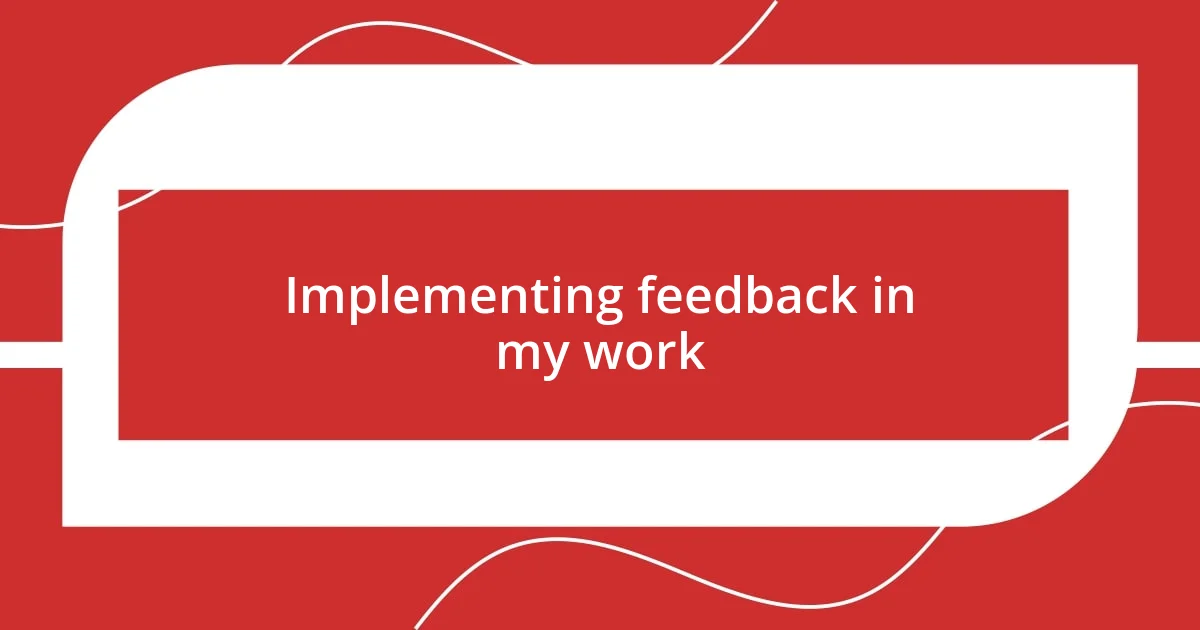
Implementing feedback in my work
Implementing feedback in my work has always been a transformative experience. I recall a time when I received feedback that challenged my entire approach to an ongoing project. In that moment, I was initially resistant—after all, my vision felt perfectly clear. But as I allowed myself to consider the critiques deeper, I realized they opened up new pathways in my thought process. By altering my technique based on the input provided, I could create something richer and more vibrant than I had originally imagined. Have you ever felt that rush of inspiration emerge from a seemingly negative comment?
As I integrated suggestions into my work, I discovered the importance of experimentation. I remember working on a painting where a fellow artist suggested I explore a different palette. Instead of feeling overwhelmed, I embraced this change. I spent a weekend mixing colors and testing them on small canvases. This act not only reinvigorated my passion but also produced a series of pieces that resonated with viewers in ways I hadn’t anticipated. It’s a reminder that genuine growth often resides outside our comfort zones, right?
While implementing feedback, I’ve also learned the value of patience. Change doesn’t have to happen overnight. I vividly recall returning to an earlier piece after a critique, equipped with new ideas but feeling a bit lost. I took my time, applying feedback gradually and revisiting the work now and then. Each session became a meditative exploration where I weighed the feedback against my artistic voice. I found that my revisions didn’t dilute my expression; instead, they enriched it. How do you feel about taking that necessary time to evolve your work? It’s a step that I believe is vital for an authentic artistic journey.
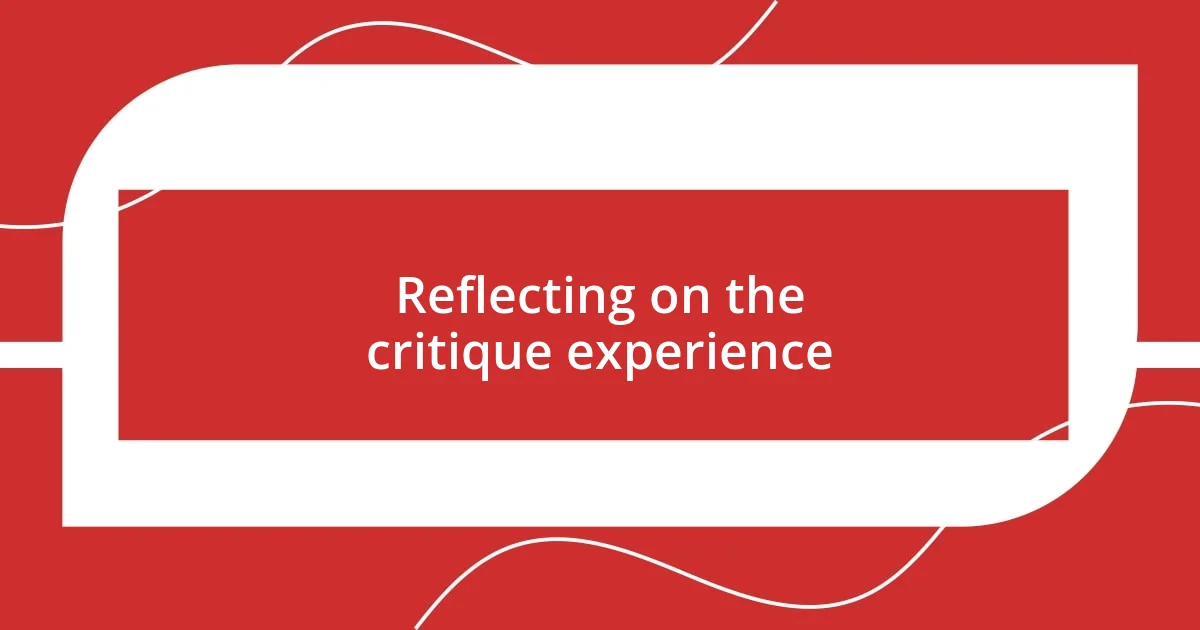
Reflecting on the critique experience
Reflecting on the critique experience can evoke a mix of emotions. I remember one critique that felt particularly tough; I left the session feeling somewhat deflated. But as I sat with those feelings, I realized they were part of the process. The tension I felt translated into motivation to reconsider my approach and strive for greater depth. Have you ever felt like a critique drained you, only to discover a well of inspiration beneath the surface?
Another aspect of reflection is recognizing the diverse perspectives that come from critiques. I once had a mentor who pointed out how different backgrounds influence interpretations of my work. Initially, I resisted this idea, thinking my intent should be crystal clear. But over time, I began to appreciate how varied interpretations could enrich my artistic narrative. Engaging with these different viewpoints has truly expanded my understanding of my work. Have you allowed others’ insights to reshape your perspective?
Lastly, I’ve come to understand the significance of time in reflecting on feedback. One day, after a critique, I took a long walk in nature—just letting thoughts swirl in my mind. As the fresh air filled my lungs, I felt a sense of clarity wash over me. I realized that reflection isn’t just about processing feedback; it’s about nurturing a relationship with my art and myself. It’s a journey of exploring how others see my work and how I translate that into my creative process. Can you recall a moment when stepping away led to a breakthrough in your thinking?


